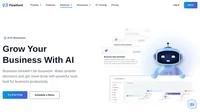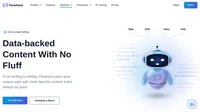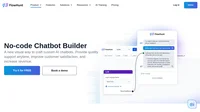What Is an Insight Engine?
An Insight Engine is an advanced search and data analysis platform that leverages artificial intelligence (AI) technologies to deliver relevant and actionable information to users from knowledge base. Unlike traditional search engines that rely on keyword matching to retrieve information, Insight Engines understand the context and intent behind user queries. They apply relevancy methods to describe, discover, organize, and analyze data from multiple sources, both structured and unstructured.
At its core, an Insight Engine integrates AI technologies such as natural language processing (NLP), machine learning (ML), semantic search, vector search, and deep learning to interpret and process vast amounts of data. This enables organizations to unlock insights hidden within their data repositories, providing users with timely and relevant information that supports decision-making processes.
How Is It Used?
Insight Engines are used to enhance information retrieval and analysis within organizations. They serve as a bridge between users and the extensive data available across various platforms and repositories. By understanding natural language queries and interpreting data contextually, Insight Engines provide precise answers and insights rather than a mere list of search results.
Organizations use Insight Engines to:
- Improve Employee Productivity: By enabling employees to quickly find relevant information across multiple data sources, Insight Engines reduce the time spent searching for information, thereby increasing productivity.
- Enhance Customer Support: Customer service representatives gain instant access to comprehensive customer information, enabling them to address inquiries effectively and improve customer satisfaction.
- Support Decision-Making: Insight Engines analyze data to uncover trends, patterns, and insights that inform strategic decisions.
- Drive Innovation: By uncovering hidden relationships and insights within data, Insight Engines foster innovation and enable organizations to stay competitive.
How Insight Engines Work
Integration of AI Technologies
Insight Engines combine several AI technologies to process and understand data:
- Natural Language Processing (NLP): NLP allows the engine to understand and interpret user queries expressed in natural language. It enables the system to comprehend context, sentiment, and intent, providing accurate and relevant responses.
- Machine Learning (ML): ML algorithms analyze data patterns and learn from user interactions. This continuous learning process improves the relevancy of search results and insights over time.
- Deep Learning: Deep learning models, such as neural networks, enable the engine to process complex data structures and understand intricate relationships within the data.
Data Sources
Insight Engines access and analyze data from a variety of sources:
- Structured Data: Databases, spreadsheets, and other organized data formats.
- Unstructured Data: Documents, emails, social media posts, PDFs, videos, and any data not organized in a predefined manner.
- Internal and External Sources: The engine can integrate data from within the organization and external sources like industry reports or public data sets.
Relevancy Methods
To deliver precise and actionable insights, Insight Engines employ various relevancy methods:
- Contextual Understanding: By analyzing the context of queries and data, the engine provides more accurate results.
- Semantics and Ontology: Understanding the meaning of words and their relationships helps in interpreting queries and data effectively.
- User Behavior Analysis: Monitoring user interactions allows the engine to personalize results based on preferences and usage patterns.
Processing User Queries
- Query Interpretation: The engine uses NLP to parse the query, understand intent, and identify key entities and concepts.
- Data Retrieval: It searches across all connected data sources to find relevant information.
- Relevancy Ranking: Results are ranked based on relevance to the query, considering context and user preferences.
- Delivery of Insights: The engine presents the information in an easily digestible format, which may include summaries, visualizations, or direct answers.
Key Features of Insight Engines
Natural Language Processing
NLP is a critical component of Insight Engines, enabling them to understand and interpret human language. This allows users to interact with the system using natural, conversational language rather than specific keywords or queries. NLP enables the engine to:
- Understand synonyms and related terms.
- Interpret complex queries.
- Recognize entities such as names, dates, and locations.
- Analyze sentiment and intent.
Intelligent Search
Insight Engines provide intelligent search capabilities that go beyond traditional keyword matching:
- Semantic Search: Understanding the meaning behind queries to deliver relevant results.
- Faceted Search: Allowing users to filter and refine search results based on specific attributes.
- Predictive Search: Offering suggestions and auto-completions based on query context.
Integration with Multiple Data Sources
An Insight Engine can connect and integrate data from various sources:
- Databases
- Document repositories
- Email servers
- CRM systems
- Social media platforms
This integration ensures that users have access to comprehensive information, regardless of where it is stored.
Personalization
By analyzing user behavior and preferences, Insight Engines personalize the information presented to each user. This includes:
- Tailoring search results based on past interactions.
- Providing recommendations relevant to the user’s role or interests.
- Anticipating user needs by proactively delivering insights.
Security and Access Control
Insight Engines handle sensitive organizational data and therefore incorporate robust security features:
- Fine-Grained Access Controls: Ensuring that users only access information they are authorized to view.
- Data Encryption: Protecting data both at rest and in transit.
- Compliance Management: Adhering to industry-specific regulations and standards.
Scalability
Designed to handle large volumes of data and high numbers of users, Insight Engines are scalable solutions:
- Distributed Architecture: Supporting data processing across multiple servers.
- Load Balancing: Managing system load to maintain performance.
- Performance Optimization: Delivering fast query responses, often within milliseconds.
Use Cases and Examples
Internal Search: Enhancing Employee Productivity
Organizations deploy Insight Engines internally to improve employee access to information:
- Knowledge Discovery: Enabling employees to find relevant documents, expertise, and data quickly.
- Expertise Location: Identifying subject matter experts within the organization based on projects, publications, or communications.
- Project Collaboration: Providing teams with access to all relevant information, facilitating collaboration and reducing redundancy.
Example: A pharmaceutical company uses an Insight Engine to allow researchers to access data across various departments. By integrating data from research papers, clinical trials, and patents, scientists can find relevant information quickly, accelerating drug development.
External Search: Enhancing Customer Support
Insight Engines improve customer interactions by providing support staff with comprehensive information:
- 360-Degree Customer View: Aggregating customer data from purchase history, support tickets, emails, and social media interactions.
- Real-Time Information Access: Allowing support representatives to access relevant information during customer interactions.
- Proactive Support: Anticipating customer needs and providing solutions before issues escalate.
Example: A telecommunications company employs an Insight Engine to assist customer service agents. When a customer calls, the agent instantly accesses the customer’s account information, recent interactions, and potential issues, enabling them to resolve queries efficiently.
Wealth Advisor Example: Informed Decision-Making
Financial advisors use Insight Engines to gather comprehensive data for client consultations:
- Market Analysis: Accessing real-time data on stocks, market trends, and economic indicators.
- Regulatory Information: Staying updated on compliance requirements and legal changes.
- Client Portfolio Management: Analyzing client portfolios to provide tailored investment advice.
Example: A wealth advisor is asked about investing in a particular stock. The Insight Engine provides a detailed analysis, including the company’s financials, market sentiment, recent news, and risk assessments. This enables the advisor to offer an informed recommendation to the client.
Case Study: Reddit’s Use of an Insight Engine
Reddit implemented an Insight Engine to improve its search functionality:
- Challenge: With millions of posts and comments daily, Reddit needed a scalable search solution that could provide relevant results quickly.
- Solution: By deploying an Insight Engine, Reddit enhanced its search capabilities, reducing search errors and improving user experience.
- Results: The number of search errors decreased significantly, and the platform could handle a high volume of searches efficiently.
Healthcare Industry: Streamlining Patient Care
In healthcare, Insight Engines assist medical professionals by providing quick access to patient data and medical knowledge:
- Patient Records: Aggregating patient history, lab results, and treatment plans.
- Medical Research: Providing access to the latest medical research and clinical guidelines.
- Diagnosis Support: Assisting in diagnosing by correlating symptoms with possible conditions.
Example: A doctor uses an Insight Engine during consultations to access comprehensive patient information and current medical research, leading to more accurate diagnoses and effective treatment plans.
Legal Industry: Efficient Information Retrieval
Law firms leverage Insight Engines to manage vast amounts of legal documents and case information:
- Document Search: Quickly finding relevant case laws, statutes, and legal precedents.
- Contract Analysis: Analyzing contracts and legal documents for clauses and compliance issues.
- Knowledge Management: Sharing expertise and insights across the firm.
Example: Attorneys use an Insight Engine to search through millions of documents for relevant cases, significantly reducing research time and improving legal strategies.
Considerations When Choosing an Insight Engine
Security
Given the sensitive nature of the data, security is paramount:
- Access Controls: Implementing user authentication and authorization mechanisms.
- Data Encryption: Ensuring data protection through encryption protocols.
- Compliance: Adhering to regulations like GDPR, HIPAA, or other industry-specific standards.
Integration
The ability to integrate with existing systems and data sources is critical:
- Data Connectors: Availability of connectors or APIs to integrate with databases, applications, and platforms.
- Flexibility: Supporting various data formats and sources.
- Ease of Implementation: Simplifying the integration process to reduce time and resource investment.
Scalability
An Insight Engine should accommodate growth in data volume and user base:
- Performance Metrics: Maintaining fast response times even as data size increases.
- Distributed Processing: Utilizing technologies that support scalable architectures.
- Resource Management: Efficiently managing computing resources to optimize performance.
User Experience
The effectiveness of an Insight Engine is influenced by its usability:
- Intuitive Interface: Providing a user-friendly interface that requires minimal training.
- Customization: Allowing users to tailor the system to their preferences and workflows.
- Mobile Access: Supporting access from various devices and platforms.
Vendor Support and Expertise
Choosing a vendor with experience and robust support services ensures successful deployment:
- Technical Support: Availability of assistance during implementation and ongoing operations.
- Customization Services: Ability to tailor the solution to specific organizational needs.
- Community and Resources: Access to documentation, user communities, and training materials.
Connection with AI, AI Automation, and Chatbots
Insight Engines are deeply connected to AI technologies and share several commonalities with AI automation and chatbots.
Shared Technologies
- Natural Language Processing: Both Insight Engines and chatbots rely on NLP to understand and interpret human language.
- Machine Learning: Continuous learning from data and user interactions improves performance over time.
- Deep Learning: Advanced models enable understanding of complex patterns and relationships.
Complementary Functions
- Information Retrieval: Insight Engines retrieve and analyze information, which can be utilized by chatbots to provide answers to user queries.
- Automated Responses: Chatbots can leverage insights generated by the Insight Engine to deliver accurate and contextually relevant responses.
- Workflow Automation: Integration of Insight Engines with AI automation tools streamlines processes and improves efficiency.
Examples
- Customer Service Chatbots: A chatbot uses the Insight Engine to access customer information and knowledge bases, providing instant support to users.
- Virtual Assistants: In an enterprise setting, virtual assistants utilize the Insight Engine to help employees find information, schedule meetings, or generate reports.
- AI-Powered Research Tools: Researchers interact with chatbots that interface with the Insight Engine to retrieve scientific data, literature, and analytics.
Research on Insight Engines with AI
Insight engines powered by AI have become an integral part of the evolving landscape of software engineering and data analysis. Below are some significant research papers that explore the various aspects of AI in enhancing insight engines and their applications:
- Lessons Learned from Educating AI Engineers
Authors: Petra Heck, Gerard Schouten
This paper discusses the insights gained from developing a practice-oriented educational program aimed at training software engineers to become AI engineers. Over three years, the program has provided valuable lessons on the professional requirements and industry expectations for AI engineers. The authors highlight the importance of practical assignments in understanding the real-world applications of AI and suggest improvements for both industry practices and academic research. Read more - Human AI Collaboration in Software Engineering: Lessons Learned from a Hands On Workshop
Authors: Muhammad Hamza, Dominik Siemon, Muhammad Azeem Akbar, Tahsinur Rahman
This study delves into the dynamics of human-AI collaboration in software engineering through the lens of a workshop involving professional engineers and ChatGPT. The research uncovers themes around AI’s evolving role from a tool to a collaborative partner, emphasizing the importance of human oversight in complex problem-solving. It provides practical insights for integrating AI tools into development processes, stressing the need for clear role allocation and effective communication. Read more - Navigating Fairness: Practitioners’ Understanding, Challenges, and Strategies in AI/ML Development
Authors: Aastha Pant, Rashina Hoda, Chakkrit Tantithamthavorn, Burak Turhan
This paper addresses the critical issue of fairness in AI/ML systems by exploring the perspectives of AI practitioners. Through interviews, the authors identify challenges, consequences, and strategies related to developing fair AI/ML systems. The study offers actionable insights into enhancing fairness and reducing bias, fostering public trust in AI technologies. It also highlights areas for further research and provides recommendations for practitioners and companies. Read more - POLARIS: A framework to guide the development of Trustworthy AI systems
Authors: Maria Teresa Baldassarre, Domenico Gigante, Marcos Kalinowski, Azzurra Ragone
In this research, the authors propose POLARIS, a comprehensive framework designed to guide the development of trustworthy AI systems. The framework addresses key issues such as transparency, accountability, and ethical considerations, providing a blueprint for creating AI applications that are reliable and fair. The paper emphasizes the importance of integrating these principles from the design phase to ensure trustworthiness in AI systems. Read more
Data-backed Content With No Fluff
Create data-driven content with FlowHunt’s AI tools. From idea generation to editing, streamline your process for engaging, SEO-optimized results!



